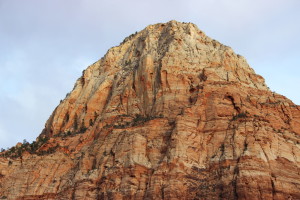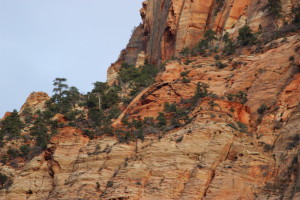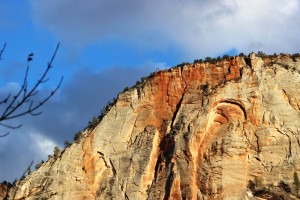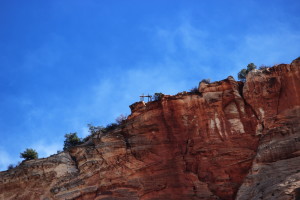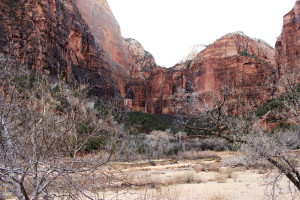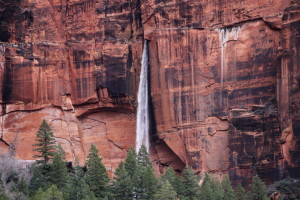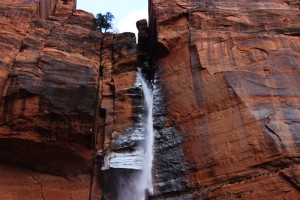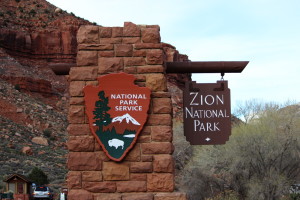 Sue and I try to get away each winter for a few days in southern Utah. It’s usually warmer than where we live and it’s fun to escape the snow and cold for a short time and enjoy some outdoors and sunshine. Our destination is Springdale, Utah and Zion National Park. The summer crowds are gone and it’s fun to have the park to ourselves!
Sue and I try to get away each winter for a few days in southern Utah. It’s usually warmer than where we live and it’s fun to escape the snow and cold for a short time and enjoy some outdoors and sunshine. Our destination is Springdale, Utah and Zion National Park. The summer crowds are gone and it’s fun to have the park to ourselves!
Summer can be quite hot in southern Utah, so it’s a perfect time of year to visit and explore the park. This year we spent three days exploring the park and saw things that we had never seen before. Here are three things that you want to make sure you don’t miss if you visit Zion National Park.
The Arch on Bridge Mountain
After many, many visits to Zion National Park, I never knew there was a natural bridge or arch hiding up on one of the mountains that you see from the time you enter the west entrance of the park. It’s not easy to see unless you are looking for it, and then you realize it’s right there in plain sight. The National Park Service has officially named it Crawford Arch.
It’s a great example of the geologic erosion forces at work in the park–to see this delicate bridge perched up out of the way on the side of the mountain is quite something. See if you can find it in the picture below. I’ll give you a hint after the picture. You will probably need to click on the picture to see it enlarged before you’ll be able to find it.
Did you find it? If not, it’s in the lower left corner, part of the patch of trees there. There is a picture of early times with someone standing on it. I’m not even sure how they got up to that area to take such a picture.
Here’s another picture, zoomed in. You can see the natural bridge easily in this picture. Again, click to see it even better.
No wonder they call it Bridge Mountain! You can easily see it if you take off at the Zion Human History Museum, which is on the left after you pass the Visitors Center, just a short distance inside the west entrance. Park in the parking lot and look east. It’s just one of the “hidden” things that you can find in the park.
Cable Works on Cable Mountain
In the early 1900’s a pioneer from Springdale, Utah, David Flanigan, constructed a cabling system from the top of what is now called Cable Mountain to the bottom of Zion Canyon. It was used primarily to transport lumber that was made from the trees on the plateau above the mountain to the floor. Lumber could be lowered in a couple of minutes, compared with many days that it would have taken otherwise to transport the lumber. In addition, fruit from the warmer climate down in Zion was transported to the top.
The cable draw works were hit by lightening a couple of times in the early days and were not used after 1930. They have slowly deteriorated over the years, but they can still be seen from Weeping Rock and from the pull out at Big Bend. See two pictures below, the first one from the Big Bend pullout and the second right below them from Weeping Rock parking lot. Look up and to the east from both parking lots.
They are a bit hard to see in the picture above, but if you click on it, they should be more obvious. You can see, them easily in the picture below, again, clicking if you need a larger picture.
As a personal note, I have ancestors that were among the initial settlers in this area and some of them worked at the sawmill on top and at the cable works helping to send lumber down to the canyon floor. Lionel Stout, brother of my great grandmother was on top of mountain right at the cable works with several other people when lightening struck, killing him and Thornton Hepworth. Their bodies were lowered from the top of the mountain to the canyon 3000 feet below by the cable. This mountain and the remaining cable works have been a tender memory for me of some of my ancestors and the challenging life they led in this beautiful, but harsh area.
Waterfalls That Appear from Magical Places
Ok, this last sight not to miss requires that you visit the park after a rainstorm, a substantial one if possible. There are waterfalls that appear in crazy places that you would not normally see.
On our trip this year, the weekend that we picked to go appeared to be a bad one. The weather was supposed to be nasty, and it wasn’t great. It is unusual to have much rain in this part of the country. It is a desert, after all. We were disappointed when it rained and snowed the entire way during our trip to Zion National Park. But when we got to Springdale, which is just outside the west entrance, the rain had let up, so we checked into our hotel and headed into the park to see what it looked like after a rain.
We were driving past Zion Lodge when I happened to look to my left and saw this amazing sight! It was a waterfall coming right out of the side of the rock!
You’ll definitely need to click on this picture to see it. We stopped, turned around, and pulled off to the side of the road and took a bunch of pictures.
Wow! It really looked like it was coming right out of the side of the rock. If you’ve been to Zion National Park before, this is in the Emerald Pools area. A couple of days later, when the weather was better, we hiked up to this area to see it close up. The water wasn’t coming out as much, but here is what it looked like from a different point of view.
There is actually a large crack that has been eroded over time and water from the rocky surface on top gets funneled to this crack, where it emerges as a waterfall. And from the road, it makes it seem like it is coming right out of the face of the rock.
If you are visiting ZIon, the Emerald Pool trail takes you right up to where this waterfall was. You get to see some amazing falls and other areas along the way. It is beautiful, fairly easy hike and is well worth your time.
If you are visiting Zion when it is raining, don’t shy away! Make sure visit the park to see things that you won’t see any other time.
That’s only three things. There are so many more that you can see in Zion National Park if you want to take the time and explore.
Have you been there? If so, what were some of your favorite things to see?
